Lyons W.C. (ed.). Standard handbook of petroleum and natural gas engineering.2001- Volume 1
Подождите немного. Документ загружается.

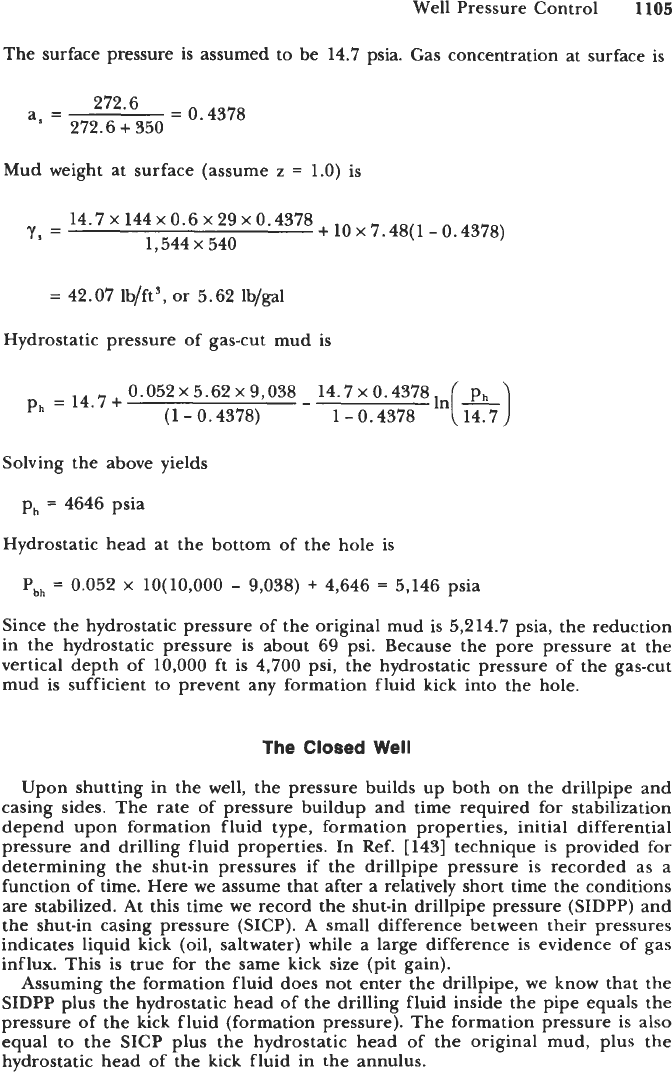
Well Pressure Control
1105
The surface pressure is assumed to be
14.7
psia. Gas concentration at surface is
a,
=
272'6
=
0.4378
272.6
+
350
Mud weight at surface (assume
z
=
1.0)
is
14.7 x 144 x 0.6
x
29
x
0.4378
+
7.
48(1
-
o.
4378)
1,544~540
Y,
=
=
42.07
lb/fts, or
5.62
lb/gal
Hydrostatic pressure of gas-cut mud is
0.052 x 5.62 x 9,038
14.7 x 0.4378
1-0.4378
(%)
ph
=
14.7
+
(1-0.4378)
Solving the above yields
ph
=
4646
psia
Hydrostatic head at the bottom of the hole
is
P,,
=
0.052
x
lO(10,OOO
-
9,038)
+
4,646
=
5,146
psia
Since the hydrostatic pressure of the original mud is
5,214.7
psia, the reduction
in the hydrostatic pressure is about
69
psi. Because the pore pressure at the
vertical depth of
10,000
ft is
4,700
psi, the hydrostatic pressure of the gas-cut
mud is sufficient to prevent any formation fluid kick into the hole.
The
Closed
Well
Upon shutting in the well, the pressure builds up both on the drillpipe and
casing sides. The rate of pressure buildup and time required for stabilization
depend upon formation fluid type, formation properties, initial differential
pressure and drilling fluid properties. In Ref.
[
1431
technique is provided for
determining the shut-in pressures if the drillpipe pressure is recorded as a
function of time. Here we assume that after a relatively short time the conditions
are stabilized. At this time we record the shut-in drillpipe pressure
(SIDPP)
and
the shut-in casing pressure (SICP).
A
small difference between their pressures
indicates liquid kick (oil, saltwater) while a large difference is evidence
of
gas
influx. This is true for the same kick size (pit gain).
Assuming the formation fluid does not enter the drillpipe, we know that the
SIDPP plus the hydrostatic head of the drilling fluid inside the pipe equals the
pressure of the kick fluid (formation pressure). The formation pressure is also
equal to the SICP plus the hydrostatic head of the original mud, plus the
hydrostatic head of the kick fluid in the annulus.
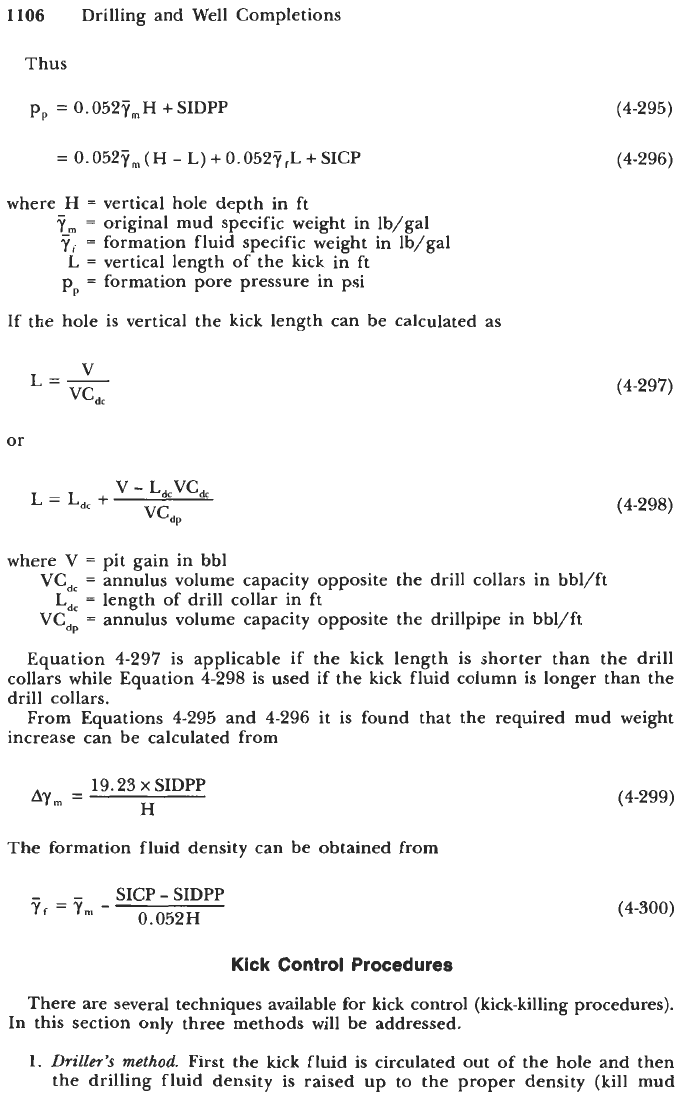
1106
Drilling and Well Completions
Thus
pp
=
0.0527,H
+
SIDPP
=
0.0527,
(H
-
L)
+
0.0527,L
+
SICP
where
H
=
vertical hole depth in ft
7,
=
original mud specific weight in Ib/gal
7,
=
formation fluid specific weight in Ib/gal
L
=
vertical length of the kick in ft
p,
=
formation pore pressure in psi
If
the hole is vertical the kick length can be calculated as
(4-295)
(4-296)
(4-297)
or
-
Ldcvcdc
L
=
L,,
+
(4-298)
“dp
where
V
=
pit
gain in
bbl
VCdc
=
annulus volume capacity opposite the drill collars in bbl/ft
VC,
=
annulus volume capacity opposite the drillpipe in bbl/ft
Ldc
=
length of drill collar in ft
Equation
4-297
is applicable if the kick length is shorter than the drill
collars while Equation
4-298
is used if the kick fluid column is longer than the
drill collars.
From Equations
4-295
and
4-296
it is found that the required mud weight
increase can be calculated from
19.23
x
SIDPP
H
AYm
=
(4-299)
The formation fluid density can be obtained from
Kick
Control Procedures
There
are
several techniques available for kick control (kick-killing procedures).
In this section only three methods will be addressed.
1.
Driller’s
method.
First the kick fluid is circulated out of the hole and then
the drilling fluid density is raised up to the proper density (kill mud

Well Pressure Control
1107
density) to replace the original mud. An alternate name for this procedure
is the two circulation method.
2.
Engineer’s method.
The drilling fluid is weighted up to kill density while
the formation fluid is being circulated out of the hole. Sometimes this
technique is known as the
one circulation method.
3.
Volumetric method.
This method is applied if the drillstring is off the
bottom.
The guiding principle of all these techniques is that bottomhole pressure is
held constant and slightly above the formation pressure at any stage
of
the
process. To choose the most suitable technique one ought to consider (a) com-
plexity of the method, (b) drilling crew experience and training, (c) maximum
expected surface and borehole pressures and (d) time needed to reestablish
pressure overbalance and resume normal drilling operations.
Driller’s Method
The driller’s method of controlling a kick is accomplished in two main steps:
Step
1.
The well is circulated at half the normal pump speed while keeping
the drillpipe pressure constant (see Figure 4-352a). This is accomplished by
adjusting the choke on the mud line
so
that the bottomhole pressure is constant
and above the formation fluid pressure. To maintain a constant bottomhole
pressure the formation fluid is allowed to expand, which usually results in a
noticeable increase in casing pressure. This step
is
completed when the forma-
tion fluid is out of the hole. At this time casing pressure should be equal to
the initial
SIDPP
if the well could be shut in.
Step
2.
When the formation fluid is out of the hole, a kill mud is circulated
down the drillpipe. To obtain constant bottomhole pressure, the casing pressure
is kept constant (see Figure 4-35213) while the drillpipe pressure drops. Once
the kill mud reaches the bottom of the hole the control moves back to the
drillpipe side. The drillpipe pressure is maintained constant (almost constant)
while the new mud fills the annulus.
Example
2
Consider the following data:
Vertical hole depth
=
10,000 ft
Hole diameter
=
S+
in.
Drillpipe diameter
=
44
in.
Mud density
=
12 lb/gal
Yield point
=
12 lb/lOO ft2
Circulating pressure at reduced speed
=
800
psi
Shut-in drillpipe pressure
=
300
psi
Calculate the following:
1.
required mud weight to restore the safe overbalance
2.
initial circulating pressure (ICP)
3. final circulating pressure (FCP)
4.
specific weight of formation fluid
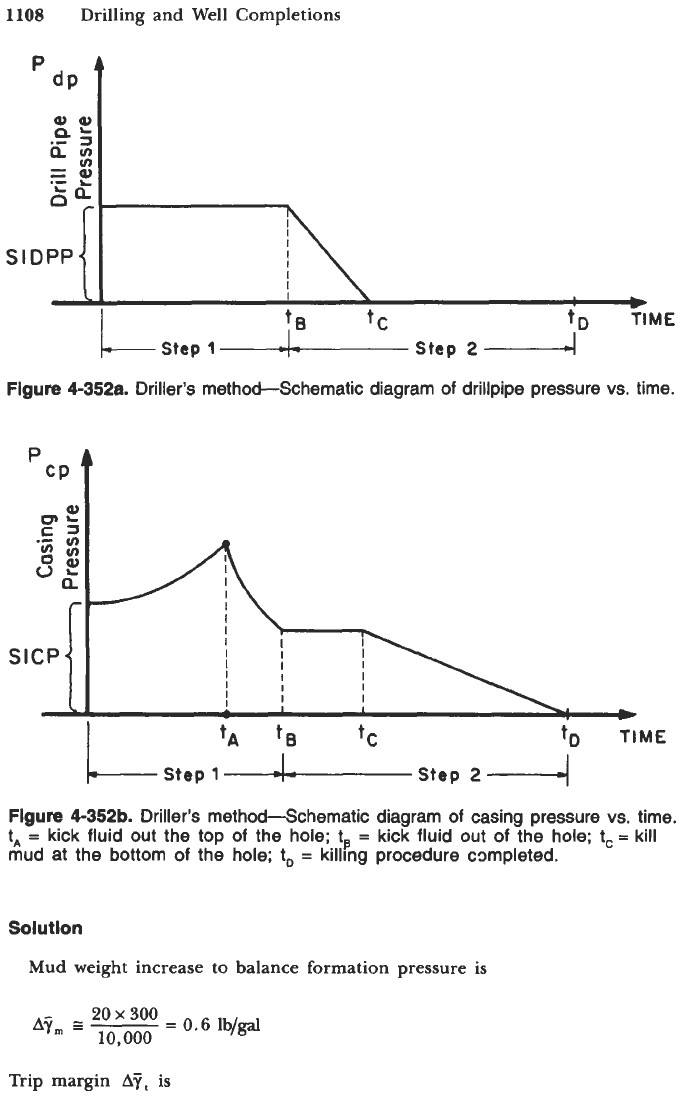
1108
Drilling and Well Completions
SI
Figure
4-352a.
Driller’s method-Schematic diagram
of
drillpipe pressure
vs.
time.
L-
Step
1
L
Step
2
-_I
Figure
4-352b.
Driller’s method-schematic diagram
of
casing pressure
vs.
time.
t,
=
kick fluid out the top
of
the hole; tg
=
kick fluid out
of
the hole; tc
=
kill
mud at the bottom
of
the hole; t,
=
killing procedure mmpleted.
Solution
Mud weight increase to balance formation pressure is
-
0.6
lb/gai
20
x
300
10,000
AT,,,
G--
Trip margin
ATt
is
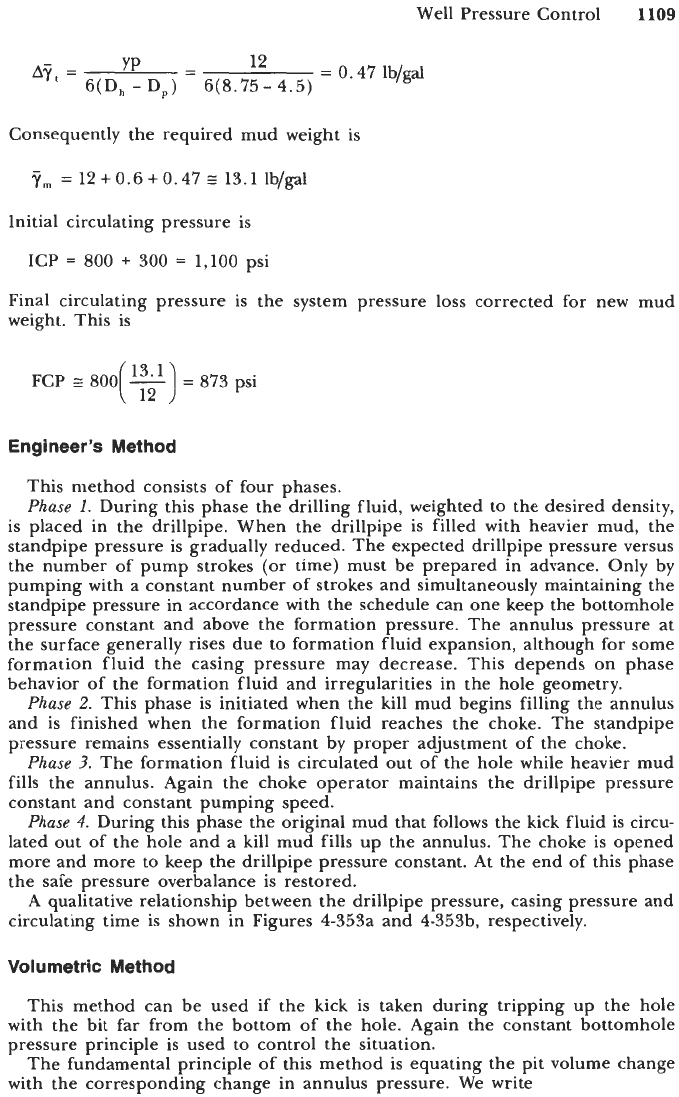
Well Pressure Control
1109
yp=
12
=
0.47 lb/gal
*"
=
6(D,
-
DP)
6(8.75- 4.5)
Consequently the required mud weight is
7,
=
12+0.6+0.47~ 13.1 lb/gal
Initial circulating pressure is
ICP
=
800
+
300
=
1,100 psi
Final circulating pressure is the system pressure loss corrected for new mud
weight. This is
FCP
z
800(
T)
=
873 psi
Engineer's Method
This method consists of four phases.
Phase
1.
During this phase the drilling fluid, weighted to the desired density,
is placed in the drillpipe. When the drillpipe is filled with heavier mud, the
standpipe pressure is gradually reduced. The expected drillpipe pressure versus
the number of pump strokes (or time) must be prepared in advance. Only by
pumping with a constant number of strokes and simultaneously maintaining the
standpipe pressure in accordance with the schedule can one keep the bottomhole
pressure constant and above the formation pressure. The annulus pressure at
the surface generally rises due to formation fluid expansion, although for some
formation fluid the casing pressure may decrease. This depends on phase
behavior of the formation fluid and irregularities in the hole geometry.
Phase
2.
This phase is initiated when the kill mud begins filling the annulus
and
is
finished when the formation fluid reaches the choke. The standpipe
pressure remains essentially constant by proper adjustment of the choke.
Phase
3.
The formation fluid
is
circulated out of the hole while heavier mud
fills the annulus. Again the choke operator maintains the drillpipe pressure
constant and constant pumping speed.
Phase
4.
During this phase the original mud that follows the kick fluid is circu-
lated out of the hole and a kill mud fills up the annulus. The choke is opened
more and more to keep the drillpipe pressure constant. At the end
of
this phase
the safe pressure overbalance is restored.
A
qualitative relationship between the drillpipe pressure, casing pressure and
circulating time is shown in Figures 4-353a and 4-353b, respectively.
Volumetric Method
This method can be used
if
the kick is taken during tripping up the hole
with the bit far from the bottom of the hole. Again the constant bottomhole
pressure principle is used to control the situation.
The fundamental principle of this method is equating the pit volume change
with the corresponding change in annulus pressure. We write
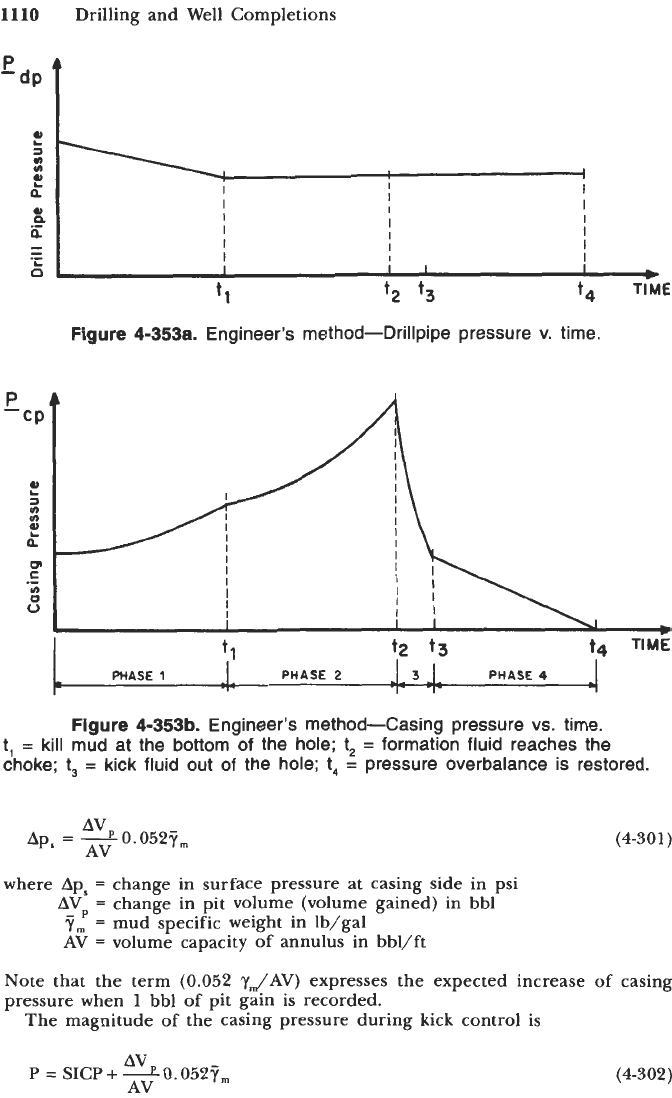
11
10
Drilling and Well Completions
P
-
dP
u
n
6
I
I
I
I
I
I
I
I
I
I
I
I
I
I
I
I
I
I
I
I
I
I
II
*
t
1
t2
t3
t4
TIME
Figure
4-353a.
Engineer’s method-Drillpipe pressure
v.
time.
I
I
I
I
I
1
C
Y)
0
u
.-
I
C
t2
t3
t4
TIME
t
1
WASE
1
PHASE
2
PHASE
4
1-
Figure
4-353b.
Engineer’s method-Casing pressure vs. time.
t,
=
kill mud at the bottom
of
the hole; t,
=
formation fluid reaches the
choke; t,
=
kick fluid out of the hole; t,
=
pressure overbalance is restored.
Ap,
=
50.0527,
AV
(4-301)
where Aps
=
change in surface pressure at casing side in psi
AVp
=
change in pit volume (volume gained) in bbl
7,
=
mud specific weight in lb/gal
AV
=
volume capacity of annulus in bbl/ft
Note that the term (0.052 yJAV) expresses the expected increase
of
casing
pressure when 1 bbl of pit gain is recorded.
The magnitude of the casing pressure during kick control is
AV
AV
P
=
sIcP+--p-o.o52y,
(4-302)
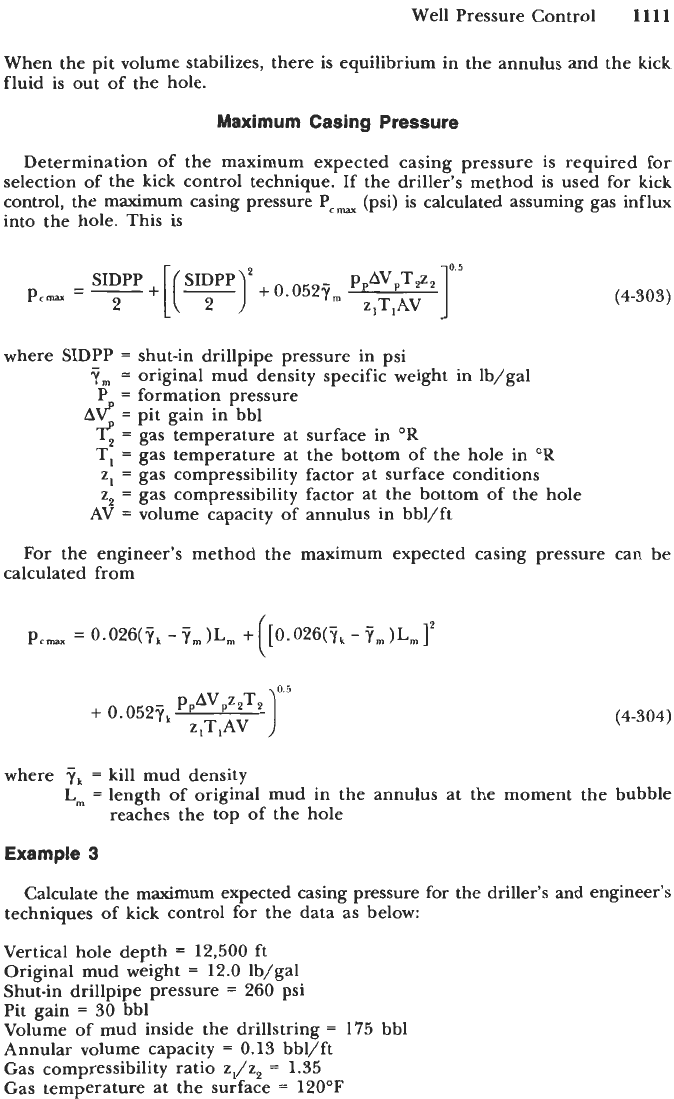
Well Pressure Control
1111
When the pit volume stabilizes, there is equilibrium in the annulus
and
the kick
fluid is out
of
the hole.
Maximum
Casing
Pressure
Determination of the maximum expected casing pressure is required for
selection of the kick control technique. If the driller’s method is used for kick
control, the maximum casing pressure
Pc,,
(psi)
is
calculated assuming gas influx
into the hole. This is
I”
+
o.0527,
Pp*VpTr?z
PC-
2
z,T,AV
(4-303)
where SIDPP
=
shut-in drillpipe pressure in psi
7,
=
original mud density specific weight in lb/gal
P
=
formation pressure
A4
=
pit gain in bbl
=
gas temperature at surface in
OR
T,
=
gas temperature at the bottom of the hole in
OR
z,
=
gas compressibility factor at surface conditions
z2
=
gas compressibility factor at the bottom of the hole
AV
=
volume capacity of annulus in bbl/ft
For the engineer’s method the maximum expected casing pressure can be
calculated from
z,T,AV
+
0.0527,
(4-304)
where
7,
=
kill mud density
Lm
=
length of original mud in the annulus at the moment the bubble
reaches the top of the hole
Example
3
techniques
of
kick control for the data as below:
Vertical hole depth
=
12,500
ft
Original mud weight
=
12.0 lb/gal
Shut-in drillpipe pressure
=
260
psi
Pit gain
=
30 bbl
Volume of mud inside the drillstring
=
175 bbl
Annular volume capacity
=
0.13 bbl/ft
Gas
compressibility ratio
ZJZ,
=
1.35
Gas temperature at the surface
=
120°F
Calculate the maximum expected casing pressure for the driller’s and engineer’s
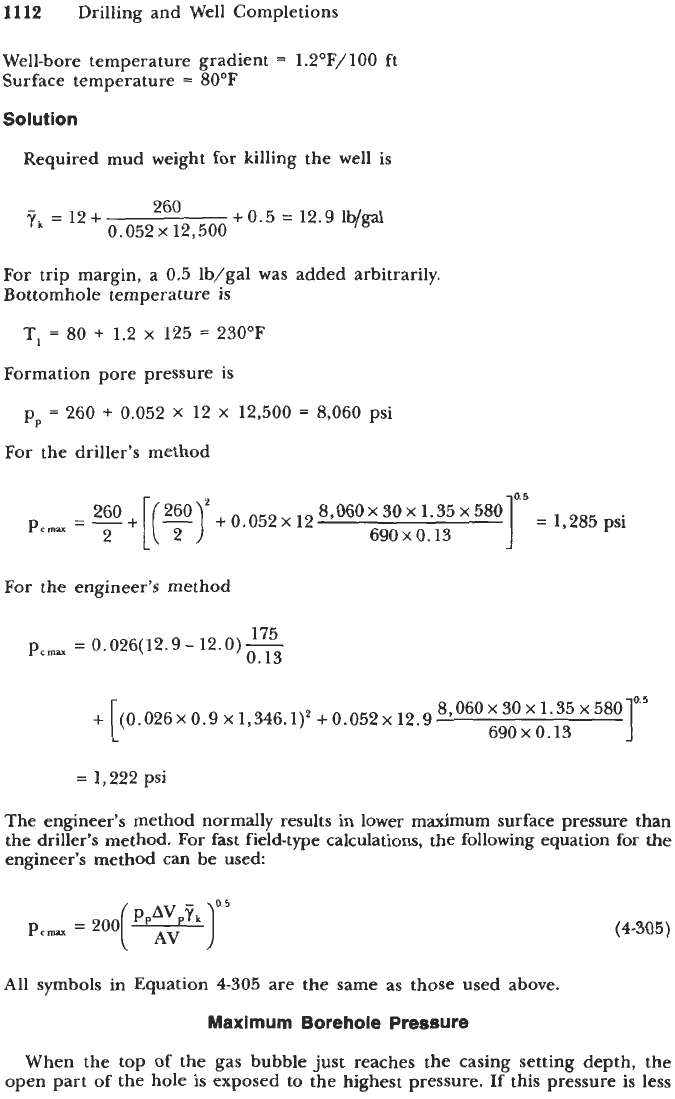
1112
Drilling and Well Completions
Well-bore temperature gradient
=
1.2”F/ 100
ft
Surface temperature
=
80°F
Solution
Required mud weight for killing the well is
7,
=
12+
260
+0.5
=
12.9
lb/gal
0.052~12,500
For trip margin, a
0.5
lb/gal was added arbitrarily.
Bottomhole temperature
is
T,
=
80
+
1.2 x 125
=
230°F
Formation pore pressure is
p,
=
260
+
0.052
x
12
x
12,500
=
8,060
psi
For
the driller’s method
8,060~30~1.35~580
=
1,285
psi
I”
=
260
+
[
(F
+
0,052
x
12
690
o.
13
2
PC-
For
the engineer’s method
175
0.13
pc,,
=
0.026(12.9
-
12.0)-
8,060~30~1.35~580
690
x
0.13
(0.026~0.9~1,346.1)* +0.052x12.9
=
1,222
psi
The engineer’s method normally results in lower maximum surface pressure than
the
driller’s method.
For
fast field-type calculations, the following equation for
the
engineer’s method
can
be
used
All symbols in Equation
4-305
are the same
as
those used above.
Maximum
Borehole Pressure
(4-305)
When the top of the gas bubble just reaches the casing setting depth,
the
open part of the hole is exposed to the highest pressure. If this pressure is less
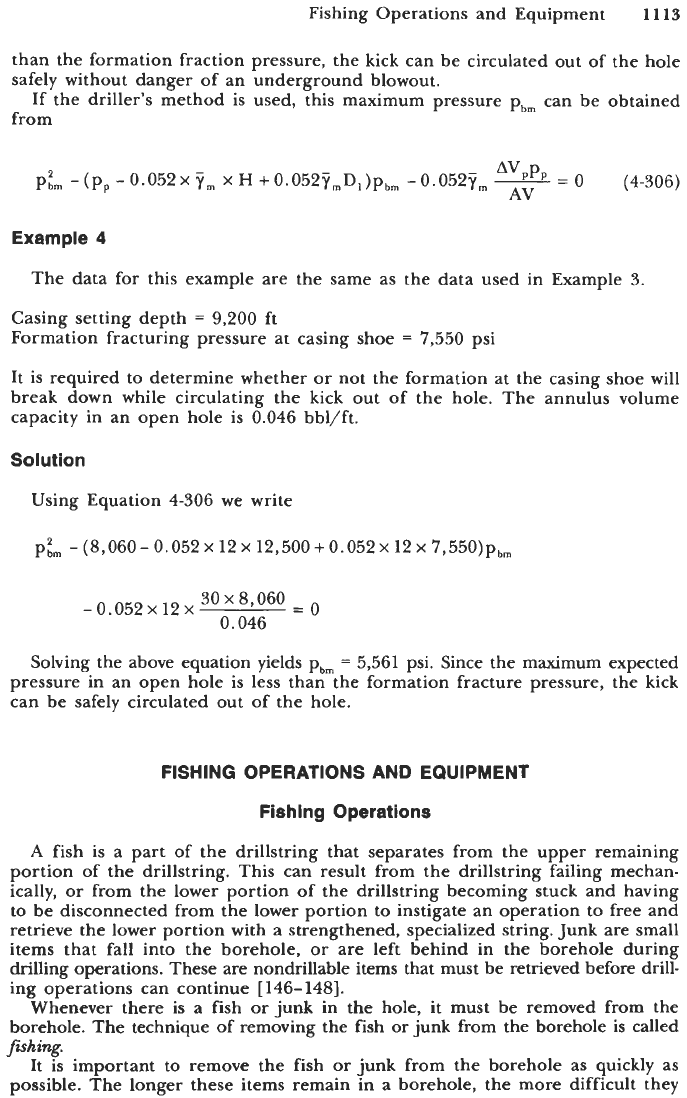
Fishing Operations and Equipment
11
13
than the formation fraction pressure, the kick can be circulated out of the hole
safely without danger of an underground blowout.
If the driller’s method is used, this maximum pressure pbm can be obtained
from
p:,,,
-
(p,
-
0.052X
7,
x
H
+
0.0527,D,)pb,,,
-
0.O52ym
-
Avppp
=
0
(4-306)
AV
Example
4
The data for this example are the same
as
the data used in Example
3.
Casing setting depth
=
9,200
ft
Formation fracturing pressure at casing shoe
=
7,550
psi
It is required to determine whether
or
not the formation at the casing shoe will
break down while circulating the kick out of the hole. The annulus volume
capacity in an open hole is
0.046
bbl/ft.
Solution
Using Equation
4-306
we write
pi,,,
-
(8,060
-
0.052
x
12
x
12,500
+
0.052
x
12
x
7,550)~~~
30
x
8,060
=
-0.052X12~
0.046
Solving the above equation yields pbm
=
5,561
psi. Since the maximum expected
pressure in an open hole is less than the formation fracture pressure, the kick
can be safely circulated out of the hole.
FISHING OPERATIONS AND EQUIPMENT
Fishing Operations
A
fish is a part of the drillstring that separates from the upper remaining
portion of the drillstring. This can result from the drillstring failing mechan-
ically,
or
from the lower portion of the drillstring becoming stuck and having
to be disconnected from the lower portion to instigate an operation
to
free and
retrieve the lower portion with a strengthened, specialized string. Junk are small
items that fall into the borehole, or are left behind in the borehole during
drilling operations. These are nondrillable items that must be retrieved before drill-
ing operations can continue
[146-1481.
Whenever
there
is
a
fish or junk in the hole, it must be removed from the
borehole. The technique
of
removing the fish
or
junk from the borehole is called
fishing.
It is important
to
remove the fish or junk from the borehole as quickly as
possible. The longer these items remain in a borehole, the more difficult they
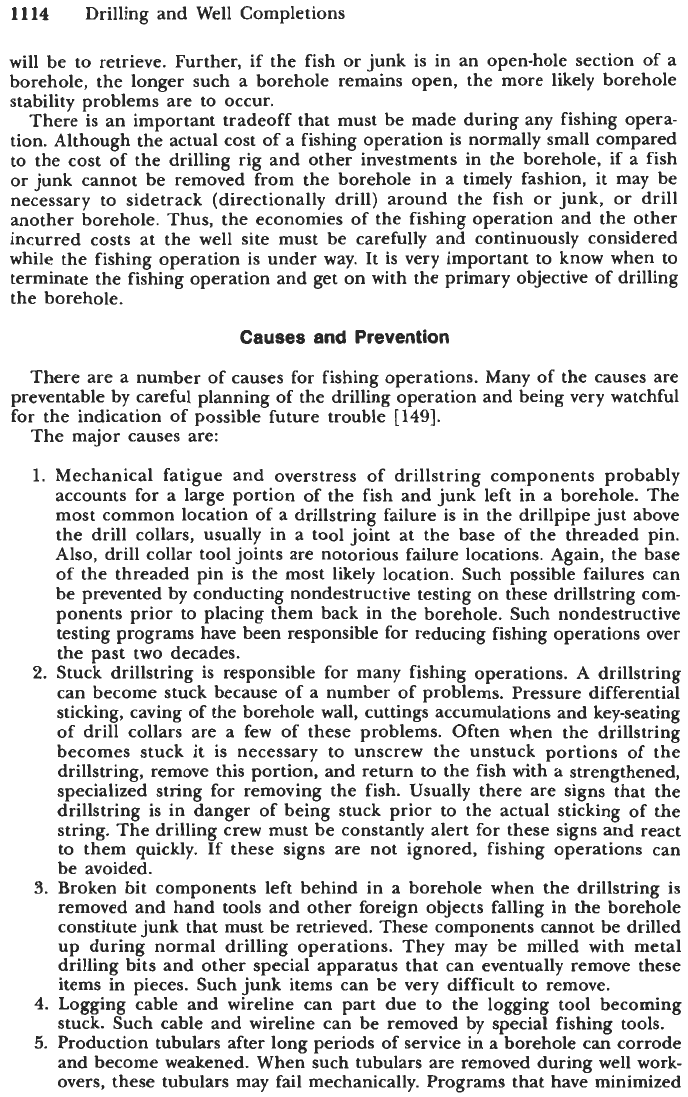
11
14
Drilling and Well Completions
will be to retrieve. Further, if the fish
or
junk is in an open-hole section of a
borehole, the longer such a borehole remains open, the more likely borehole
stability problems are to occur.
There is an important tradeoff that must be made during any fishing opera-
tion. Although the actual cost of a fishing operation is normally small compared
to the cost of the drilling rig and other investments in the borehole, if a fish
or junk cannot be removed from the borehole in a timely fashion, it may be
necessary to sidetrack (directionally drill) around the fish
or
junk,
or
drill
another borehole. Thus, the economies of the fishing operation and the other
incurred costs at the well site must be carefully and continuously considered
while the fishing operation is under way. It is very important
to
know when to
terminate the fishing operation and get on with the primary objective of drilling
the borehole.
Causes
and
Prevention
There are a number of causes for fishing operations. Many of the causes are
preventable by careful planning of the drilling operation and being very watchful
for
the
indication of possible future trouble
[
1491.
The major causes are:
1.
Mechanical fatigue and overstress of drillstring components probably
accounts for a large portion of the fish and junk left in a borehole. The
most common location of a drillstring failure is in the drillpipe just above
the drill collars, usually in a tool joint at the base of the threaded pin.
Also, drill collar tool joints are notorious failure locations. Again, the base
of
the threaded pin is the most likely location. Such possible failures can
be prevented by conducting nondestructive testing on these drillstring com-
ponents prior to placing them back in the borehole. Such nondestructive
testing programs have been responsible for reducing fishing operations over
the past two decades.
2.
Stuck drillstring is responsible for many fishing operations.
A
drillstring
can become stuck because of a number of problems. Pressure differential
sticking, caving of the borehole wall, cuttings accumulations and key-seating
of drill collars are a few of these problems. Often when the drillstring
becomes stuck it is necessary to unscrew the unstuck portions of the
drillstring, remove this portion, and return to the fish with a strengthened,
specialized string for removing the fish. Usually there are signs that the
drillstring is in danger
of
being stuck prior to the actual sticking of the
string. The drilling crew must be constantly alert for these signs and react
to them quickly. If these signs are not ignored, fishing operations can
be avoided.
3.
Broken bit components left behind in a borehole when the drillstring is
removed and hand tools and other foreign objects falling in the borehole
constitute junk that must be retrieved. These components cannot be drilled
up during normal drilling operations. They may be milled with metal
drilling bits and other special apparatus that can eventually remove these
items in pieces. Such junk items can be very difficult to remove.
4.
Logging cable and wireline can part due to the logging tool becoming
stuck. Such cable and wireline can be removed by special fishing tools.
5.
Production tubulars after long periods of service in a borehole can corrode
and become weakened. When such tubulars are removed during well work-
overs, these tubulars may fail mechanically. Programs that have minimized
